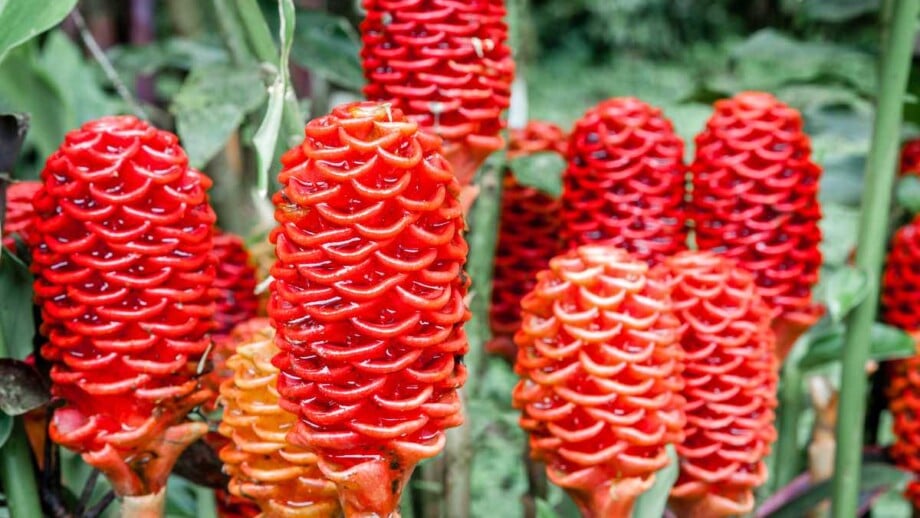The Shampoo Ginger Lily plant (Zingiber zerumbet), also known as Awapuhi Kuahiwi, red pinecone ginger, and bitter ginger, is a plant that you may not be familiar with unless you’ve visited Hawaii.
It is native to India, but Polynesian settlers brought it to Hawaii, where its flower head produces ginger-scented fluid that is still used in shampoos and conditioners.
The roots have traditionally been used as medicine and dried to make a fragrant powder. The roots of the plant, called rhizomes, can be eaten and used like ginger, though they are more bitter hence the reason why it’s also known as bitter ginger! In Java, the leaves were used to add flavor to meat that was baked.
Fortunately, you can easily grow this plant both indoors and outdoors to enjoy its stunning, exotic looks that can add a flair to any landscape or utilize it for its innumerable uses. Read our guide for shampoo ginger lily to learn everything you need to know to maintain a healthy, thriving plant.
https://www.youtube.com/watch?v=6JyGQ8auCUIBotanical Name: Zingiber zerumbet
Common Name: Shampoo ginger lily, Awapuhi Kuahiwi, shampoo lily, red pinecone ginger, bitter ginger
Family: Zingiberaceae
Plant Type: Perennial herbaceous
Hardiness Zones: 8 – 12 (USDA)
Sun Exposure: Full sun to partial shade
Soil Type: Nutrient-rich, well-draining soil
Soil pH: Slightly acidic to neutral (5.7 to 8.0)
Maturity: 10 months
Height: 4 to 6 feet fall
Spacing: 24 to 36 inches
Bloom Time: Summer to early fall

Quick Guide: Planting, Growing & Caring for Shampoo Ginger Lily
- Tropical plant native to Asia that has been naturalized in Hawaii
- Prefers full to partial shade with at least 6 hours of direct sunlight a day
- Grow it in nutrient-rich soil that’s slightly acidic to neutral, and keep the soil consistently moist but not waterlogged
- These tropical plants prefer warm and humid conditions, though they are hardier than other tropical plants.

Photo Credit: Dreamstime.
Shampoo Ginger Lily Plant Care
Shampoo ginger lily is native to India and other tropical parts of Asia, but Polynesian settlers brought it to Hawaii, where its flower head (inflorescence) produces ginger-scented fluid that is still used in shampoos and hair conditioners.
It serves as an exotic landscape accent because of its bright green foliage and vibrant red inflorescences that resemble cones. When used as cut flowers, they make a lovely floral arrangement, and they are also used as ornamental plants.
Shampoo ginger lily rhizomes are similar to those of ginger and turmeric because it also belongs to the Zingiberaceae ginger plant family. Although they have a bitter taste, they are edible and have historically been used to treat digestive problems like diarrhea and intestinal worms.
It produces bright red flowers that stand 2 to 4 inches tall during its growing season, which lasts from spring to late summer, and its red pine cones have a fresh, ginger-like scent.
Light
Shampoo ginger lily plants prefer full sun to partial shade and at least 6 hours of direct sunlight per day.
If you want to grow them indoors, you can put them near South or West-facing windows, which get the most light all day. Even a window facing east will do. The least amount of sunlight comes in through windows that face north, so your Shampoo ginger may not do well there.
Place the plant in a location that receives bright, diffused light for at least half the day if you plan on growing it outdoors. This is preferably in a spot that is partially shaded.
Soil
Pinecone ginger prefers nutrient-rich soil with a pH range of slightly acidic to neutral. Plant it in a container with rich potting soil if you live in a region where the plant is regarded as aggressive or invasive.
If growing indoors, use a standard houseplant soil mix and supplement with perlite, vermiculite, or orchid bark to ensure that excess water drains well.
In order to prevent the soil from becoming waterlogged, be sure to plant your shampoo ginger in a container with drainage holes. Waterlogging increases the risk of root rot as well as other fungal diseases.
Water
During their growing season, from late spring to late fall, shampoo ginger plants thrive in consistently moist soil. Keep the plant dry during the winter as it enters dormancy.
As a general rule, your plant should be watered once per week. To avoid fungal infections, water the soil directly rather than the leaves.
Be sure to use a container with drainage holes when planting. Using tap water can lead to a buildup of salts, so distilled water or rainwater is generally recommended instead.
Temperature and Humidity
These are tropical plants, so they like it when it’s warm and humid. However, they can be grown outside in zones as low as 8, and they can handle cold better than other tropical plants. Shampoo ginger plants will thrive in general household temperatures.
Temperatures should be kept above 55 degrees Fahrenheit, though these plants can tolerate temperatures as low as 20 degrees Fahrenheit.
You should bring your plant indoors to overwinter it if you’re growing it outdoors and outside of USDA zones 8 to 12. Instead of overwintering indoors, growers in USDA zone 8 can add mulch to protect their rhizomes from frost during the winter.
If you live in a zone that is not between 8 and 12, you can dig up the rhizomes (roots) of the plant in the late fall, after the growing season has ended, and store them until the following year.
Since they are tropical plants, the humidity should be at least 50%. If your house has trouble with humidity, there are several ways to bring in more moisture. To increase humidity, you can use a humidifier, group similar plants together, or set your plant on a tray of pebbles and water.
Fertilizer
Only fertilize during the growing season. To promote the growth of a healthy rhizome or bloom, you should provide them with phosphorus-rich fertilizer. Look for a fertilizer with a higher P number in the NPK indicated on the packaging.
If you want to give your shampoo ginger plants a boost without resorting to commercial fertilizers, you can do so by applying compost tea twice a month throughout the growing season.
Pruning
Keep an eye out for spent shampoo ginger lily flowers as the plant ages and the flower color changes from green to red.
As the plant stops producing, remove them. Cut the plant’s stem near the base. Plant stems and leaves can be used to flavor food, and the liquid from the flowers can be used to make shampoo, or the oils from the roots can be extracted.
How to Plant and Grow Shampoo Ginger Lily
How to Propagate Shampoo Ginger Lily
Shampoo ginger lily plants can be propagated through seeds, but seeds are typically difficult to find. The most common method for propagating shampoo ginger is by using rhizomes.
Put on gloves and have sterilized shears on hand before you begin propagation.
You need to dig up your plant so that the rhizomes are exposed. These rhizomes, which are roots, look like the ginger you buy at the store.
You should remove enough of a rhizome so that it contains multiple buds. Give the cuts a few days to dry out and harden.
After that, soak the roots in a container of warm water overnight before planting. Plant the rhizomes with the buds facing up in a new container that has been filled with an equal mixture of soil and compost.
Keep the plant indoors in a warm, sheltered spot with plenty of indirect light. Maintain a consistent watering schedule and fertilizer applications every other week for your plant until the rhizomes begin to sprout.

How to Grow Shampoo Ginger Lily from Seeds
It is uncommon to grow shampoo ginger from seed. If you can get shampoo ginger plant seeds from a reputable seller, here’s what you need to do to get your shampoo plant going.
Start by taking your seeds and soaking them in water overnight. They should appear swollen afterward. Then fill a seedling tray with a seed starting mix or nutrient-dense medium.
Place the seeds in the growing medium. If you’re putting multiple seeds in the same container, make sure they’re at least 1 to 2 inches apart.
Put your seedling tray somewhere warm and humid. You can help it grow by covering it with plastic wrap and putting it on a heated seedling tray.
It may take a few weeks to germinate and 1 to 2 months to grow before transplanting.

Common Pests and Plant Diseases for Shampoo Ginger Lily
The most common problem with your Shampoo Ginger Lily is fungal infections caused by root rot from overwatering.
However, they are also susceptible to having problems with pests such as spider mites and mealybugs. You can eliminate mealybugs and spider mites by spraying your plant with water, allowing it to dry, and then spraying it with neem oil.
A pest called the cardamom root grub can harm the roots of your new plant. The stems and foliage will turn yellow if the infestation is severe. To treat the problem, use insecticidal soap.
Apart from root rot, overwatering can also lead to soft rot, yellowing of the leaves, and stunted growth with a rotten brownish base. The best method is to remove the plant, preserve any healthy roots, and replant it in a pot containing new soil.


Other Plant Guides from Planet Natural:
Money Plant: How to Grow, and Care for Chinese Money Plant
11 Best Indoor Plants of 2023 (Easy, Low-Maintenance Plants)











